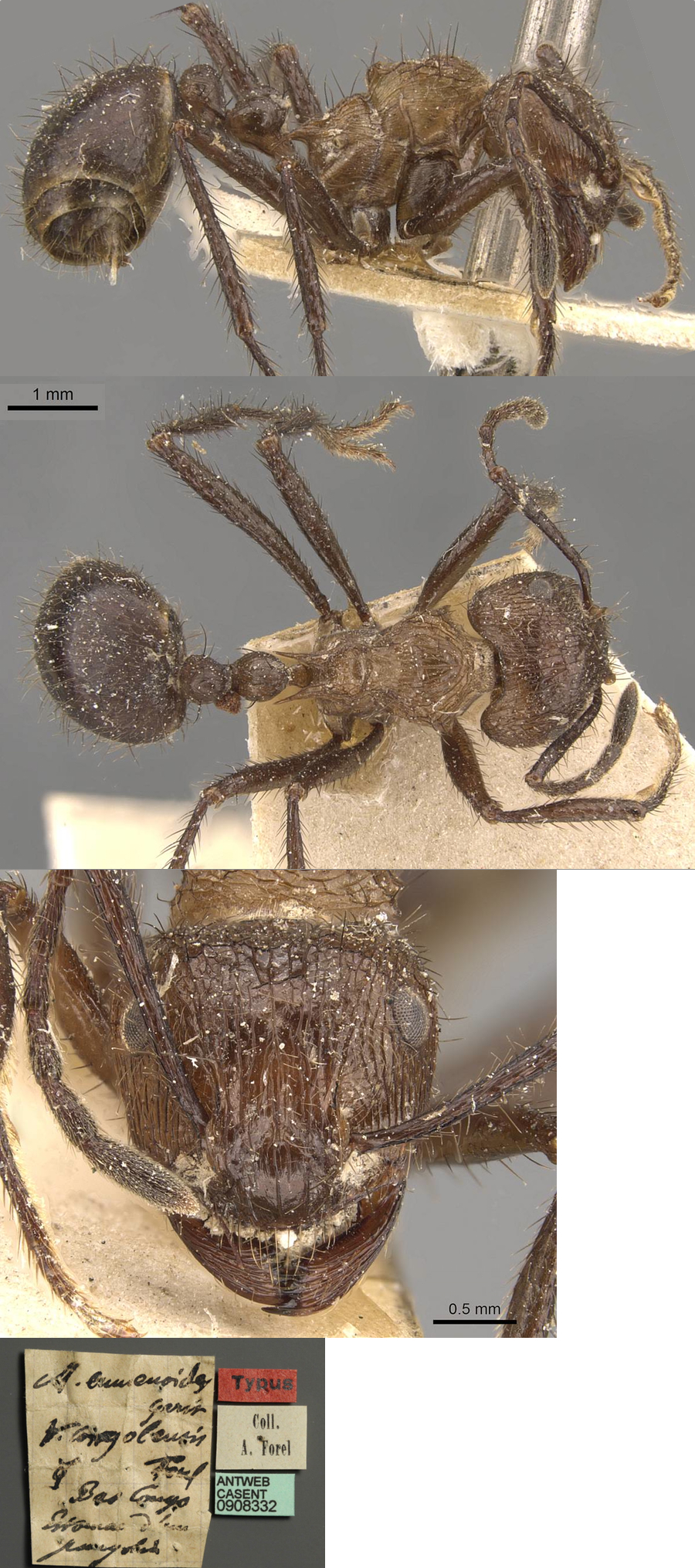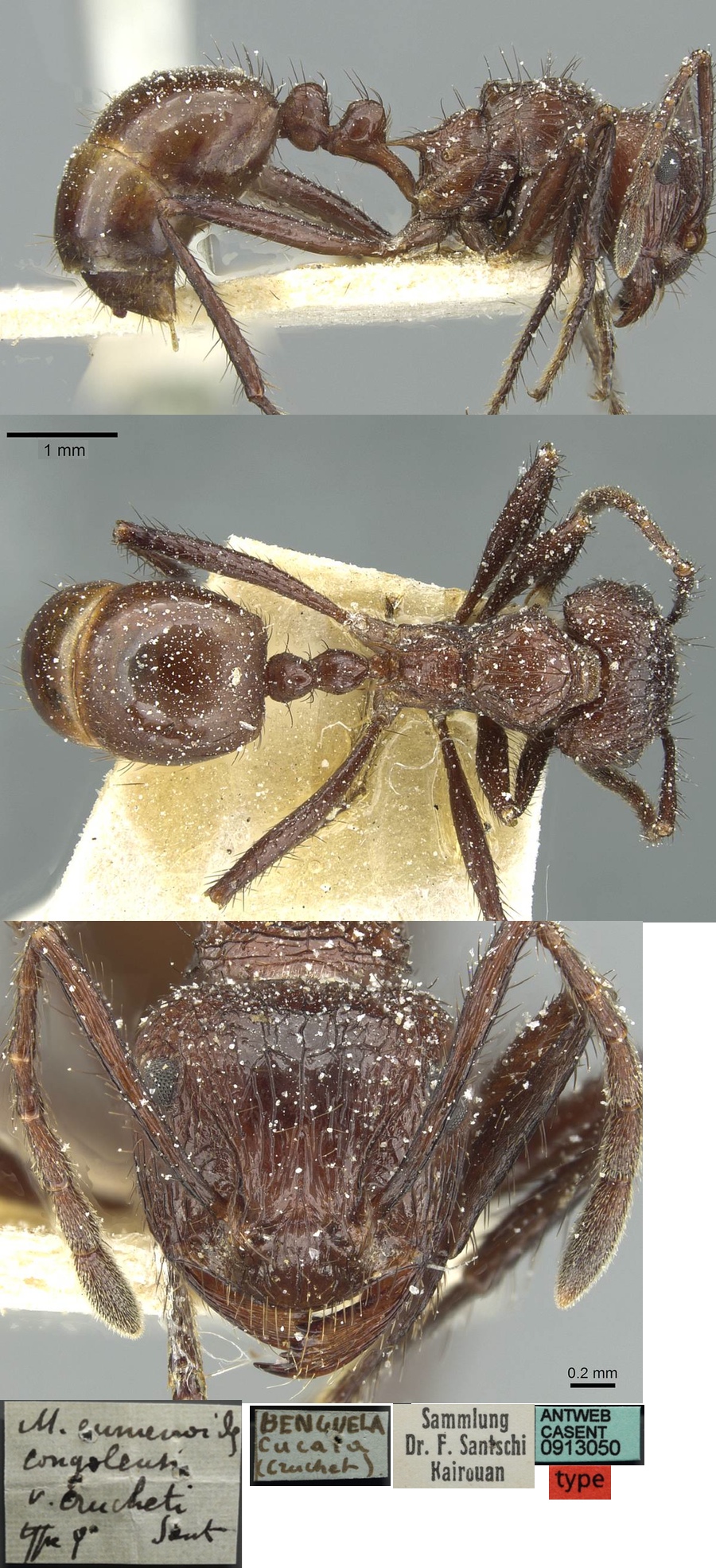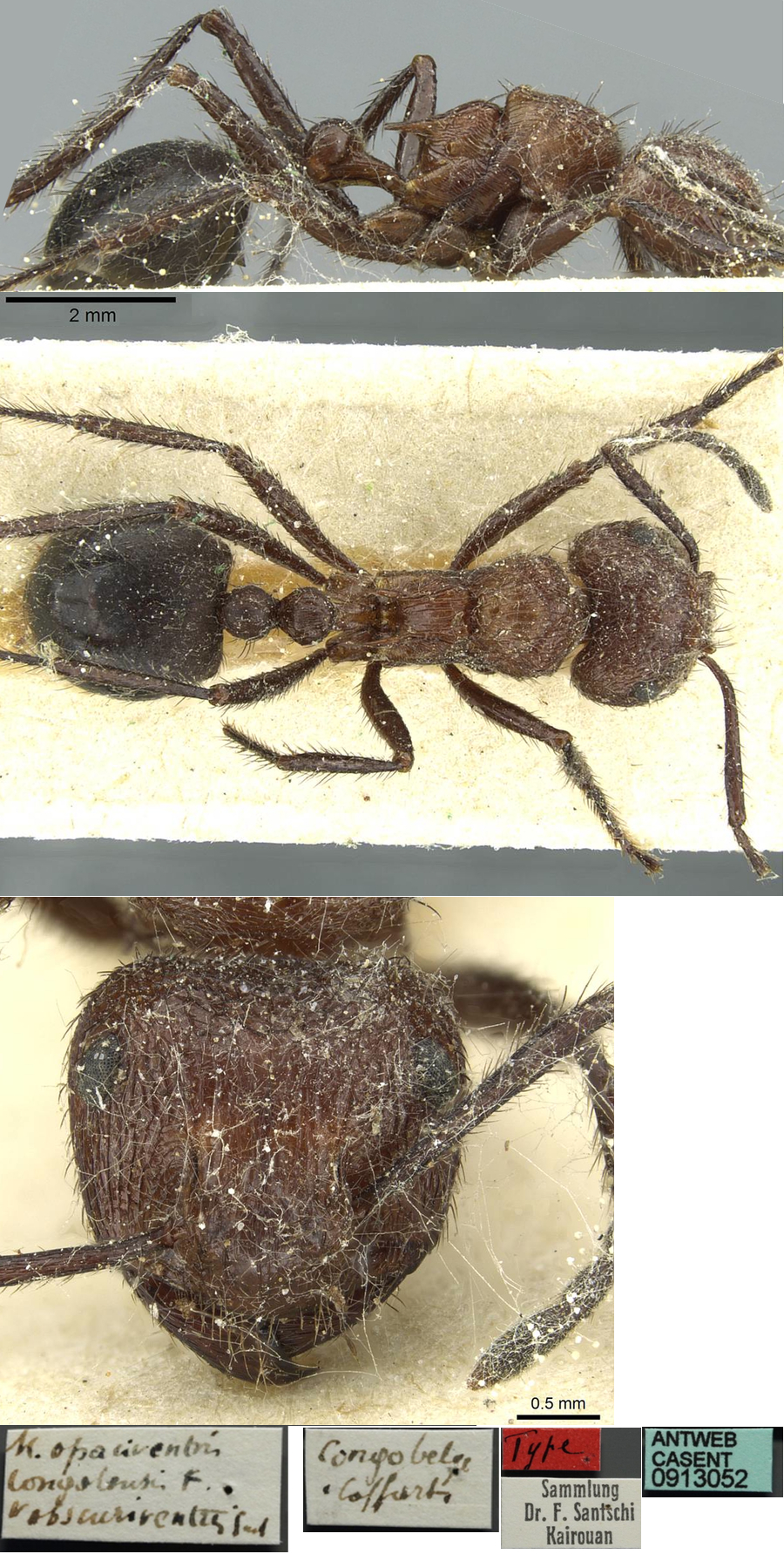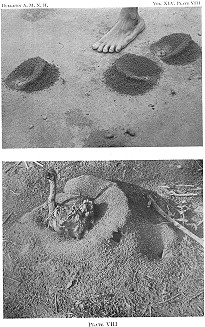Myrmicaria congolensis Forel - new status
  Type location Zaïre (Myrmicaria
eumenoides Gerst. v. congolensis n. var., Forel, 1909b: 59,
worker; Forel, 1913h: 354, male; Santschi, 1925c: 150, queen - see below Type location Zaïre (Myrmicaria
eumenoides Gerst. v. congolensis n. var., Forel, 1909b: 59,
worker; Forel, 1913h: 354, male; Santschi, 1925c: 150, queen - see below
junior
synonyms (here)
crucheti (Myrmicaria eumenoides Gerst.
stirps congolensis For. Crucheti
n. var. , Santschi, 1913c:
311; Santschi, 1925c: 151, worker & queen) from Angola,
Benguela, Cucala, J Cruchet - see below
obscuripes (Myrmicaria
opaciventris Em. v. obscuripes
n.v., Santschi,
1937a: 57, worker) from Zaïre, collector Goffat - see below
(label has name "obscuriventris")
(see Bolton, 1995)  . .
|
M. congolensis was a stirps/subpsecies of eumenoides
in Santschi (1914b: 115) and Santschi (1914d: 342). This was changed to
a subspecies of natalensis by Emery (1922e: 123) and then to a
subspecies of opaciventris by Santschi (1925c: 149; 1937b:
101). Assuming
the description and illustration of the pedicel of Myrmicaria
opaciventris given by Emery (1893e) is accurate, it is clear
that Santschi (1925c) erred in placing congolensis under opaciventris.
Accordingly, I have raised congolensis, as represented by the
specimens photographed here, to species status.
|
 Forel's
(1909b) description of congolensis is at Forel's
(1909b) description of congolensis is at  . Stitz's (1910)
description of nitida is at . Stitz's (1910)
description of nitida is at  .
Santschi's (1913c) description of crucheti
is at .
Santschi's (1913c) description of crucheti
is at  . Santschi's (1937a: 57)
description of obscuripes is at . Santschi's (1937a: 57)
description of obscuripes is at  . .
|
 The photomontage of the
type worker is collated from http://www.antweb.org/specimen.do?name=casent0908332. The photomontage of the
type worker is collated from http://www.antweb.org/specimen.do?name=casent0908332.
|
Type
form
Santschi's (1925c) description of the congolensis
type, which follows, shows there to be variability between the larger
workers (majors) and smaller minors in details of sculpturation.
WORKER - TL 5.5-7.7 mm. Yellowish red-brown.
Antennae, tarsi and gaster red-brown, rest of legs and pedicel lighter.
Central area of head more densely longitudinally striated than natalensis
(with 10-13 striae between the frontal carinae. Transverse ridge of the
vertex very sinuous forming a W-shaped anastomosis. Occipitum with
20-24 striae. Scape area more strongly rugose and the sides of the head
without smooth spaces. Median carina of pronotum traversed in the
anterior portion or up to the anterior two-thirds by arcuate collateral
rugae. Mesonotal dorsum with 12 rugae in the majors and 5 in the
smallest workers with a few reaching onto the declivity, but without a
ridge separating the dorsum and declivity. Propodeal dorsum also
longitudinally striate, more densely in majors. Sides of alitrunk with
regular longitudinal striations and no smooth spaces. Pedicel nodes
with fine rugae in the majors, nodes in minors smooth. Dorsum of gaster
entirely matt in majors; matt forward but smooth and shiny posteriorly
in minors. Inter-rugal spaces variable from shiny in minors to matt in
majors. Scapes and tibiae striated. Erect pilosity distributed as in natalensis.
Comparisons with natalensis - overall
shape similar; but sides of head somewhat more convex; frontal area
more distinct; mandible with 4-5 teeth; pronotum dorsum a little
flatter; promesonotal suture strongly distinct; propodeum more strongly
carinate; mesonotal lobes raised in profile; propodeal dorsum half to
two-thirds longer than wide, slightly concave anteriorly; propodeal
spines a little stronger and directed downwards more obviously; pedicel
of petiole more slender; petiole node a little lower, with the anterior
and posterior borders less symmetric; postpetiole with a shorter base,
slightly higher, anterior face oblique but less so than striata.
Forel (1909b) noted the postpetiole ventral process in congolensis
is rectangular, longitudinal and translucent (that of natalensis,
eumenoides is an obtuse tubercle, see illustration
above).
Santschi noted that Wheeler had cited this form from
several localities in Zaïre. He, having regard to the rich supply of
specimens from numerous points of the regions (I guess he means the
Congo Basin), felt that the type form was not widely represented. The
type location was localized in the Benguela area of Angola and shared
its habitat with the equally abundant opaca Santschi of Atopomyrmex
mocquerysi. These forms of the two species shared remarkable and
distinct characters of colour and sculpture. Santschi posed the
question - was it mere coincidence or were they subject to a special
pressure from the local ecology or was there some unknown biological
affinity between them?
Santschi also gave the following key below , in which I retain opaciventris,
as well as continuing from his separation of the subspecies of congolensis;
curiously Santschi did not included obscuripes.
|
junior synonym crucheti
(Santschi)
WORKER -
Distinguished from congolensis
by propodeal spines being straight and fine and by its colour being of
a more brownish red, appendages and gaster of darker brown sometimes
blackish. Also notably smaller and more thickset.
 The
photomontage of the crucheti type worker is collated from http://www.antweb.org/specimen.do?name=casent0913050. The
photomontage of the crucheti type worker is collated from http://www.antweb.org/specimen.do?name=casent0913050.
|
Subspecies obscuripes Santschi
 WORKER
- TL 7-0-9.5 mm; sculpturation more
pronounced than in congolensis; propodeal spines straight and
horizontal, wide at the base (as with the largest mesonotalis);
from above the petiole node is wider than the postpetiole and a little
wider than long; rest as mesonotalis but overall darker with
the mesonotum concolorous with the rest of the alitrunk and the form
stronger; alitrunk darkish red-brown, head usually duller, appendages
and pedicel darker red to near black, gaster black, base matt, shiny
posteriorly. WORKER
- TL 7-0-9.5 mm; sculpturation more
pronounced than in congolensis; propodeal spines straight and
horizontal, wide at the base (as with the largest mesonotalis);
from above the petiole node is wider than the postpetiole and a little
wider than long; rest as mesonotalis but overall darker with
the mesonotum concolorous with the rest of the alitrunk and the form
stronger; alitrunk darkish red-brown, head usually duller, appendages
and pedicel darker red to near black, gaster black, base matt, shiny
posteriorly.
Specimens from an unknown Zaïre location (type) and Kenya
(from H Donisthorpe) a smaller specimen (Santschi, 1913c).
The
photomontage of the obscuripes
type worker is collated from http://www.antweb.org/specimen.do?name=casent0913052.
|
Notes on the descriptions and analysis of Wheeler
(1922)
Wheeler (1922), regarded opaciventris and/or congolensis
as a subspecies of eumenoides but I have used natalensis
where Wheeler used eumenoides. His observations were -:
Neither Forel nor Santschi seems to me to have recognized this form
very explicitly. Several years ago I received from the former six
workers labelled "Benguela (Buchner)" and, as Emery's ergatotypes bore
the same label and were also received from Forel and as my specimens
agree perfectly with Emery's description, I feel confident that they
are cotypes. Later I received a worker and three dealated females from
Gaboon (Staudinger) and, as Emery mentions specimens from the same
locality , I believe that I have before me also the female of the true opaciventris.
The workers measure about 5 to 6 mm and are pale ferruginous brown,
with the antennae, legs, and gaster more fuscous. The mandibles have
oblique 5-toothed blades; the clypeus is carinate. The propodeal spines
are rather slender and very slightly bent downward, the base of the
propodeum is less concave than in the typical natalensis, the
peduncle of the petiole is distinctly shorter and not longer than the
node. The petiole and postpetiole nodes are laterally compressed and of
the same height, the ventral surface of the postpetiole, unlike that of
natalensis, is swollen, and projecting and angular
in front. The surface of the head and thorax is somewhat less shining
than in natalensis, the rugae on the front, pleurae, pro-,
meso- and base of propodeum more sharply and regularly longitudinal and
not reticulate. The gaster has the basal half or, in some specimens,
the whole surface opaque and densely punctate, whereas it is smooth and
shining in typical natalensis. The nodes of the petiole and
postpetiole have shining summits and in some specimens the sides of the
petiole are also smooth and shining, in others like those of the
postpetiole, finely punctate and even feebly longitudinally rugulose.
In the female, which measures 13 mm, the petiole and postpetiole are
sharply longitudinally rugose, the summit of the former concentrically
rugose, the scutellum vermiculately rugose. Emery's description of the
male, which I have not seen, includes no mention of characters that
would distinguish it from the male of the typical natalensis.
Numerous specimens from the various Congo localities cited above seem
to me to be referable to Emery's subspecies, though they differ more or
less in the sculpture of the petiole, postpetiole, and gaster and in
being mostly of a darker color. They average larger than the specimens
of variety congolensis and variety crucheti, the
workers being 5 to 6.5 mm. The petiole and postpetiole, especially the
latter, are nearly always more or less longitudinally rugulose on the
sides, though sometimes merely punctate, as Emery remarks in the
original description. The specimens from Walikale have the entire
gaster opaque and punctate, whereas in others it is punctate usually
only on the anterior half of the first segment. This character,
however, varies in individuals from the same colony. Santschi says that
the gaster of the worker is "entièrement sculpté, mat, brun clair," but
Emery describes the gaster as fuscescent, with the anterior half of the
first segment opaque.
In Zaïre, the typical nests observed by Lang were "as a rule built at
the bases of trees and bushes, can be easily recognized by the mound of
earth thrown up while the chambers are being excavated".
Variety congolensis (Forel). Wheeler
noted - This form is not represented among the material collected by
Lang, Chapin, and Bequaert. Santschi regards it as an independent
subspecies, but it seems to me to be merely a variety of opaciventris.
Three cotypes of congolensis were given me by Forel. Comparison
of these specimens with opaciventris show relatively slight
differences. They are somewhat smaller, of a more sordid yellowish
brown color and with much the same sculpture and lower portion of the
postpetiole. The propodeal spines, however, are decidedly more slender
and more strongly deflected, a character not mentioned in Ford's
original description, though noted by Santschi; the head is
proportionally smaller and narrower, with straight cheeks, and the
gaster is opaque only at the base of the first segment, the remainder
being rather shining.
Variety crucheti (Santschi). Wheeler
referred numerous specimens (from Zaïre localities) to the variety crucheti
since they agree with Santschi's very brief description in size (5 to
5.5 mm) and in having slender but straight propodeal spines. The
petiolar node is distinctly broader and less compressed laterally than
in the typical natalensis and not shorter than the peduncle.
The surface of the petiole is not so smooth, though it is not
longitudinally rugulose. I have received this same form in all three
phases from Rev. Geo. Schwab, who took it at Metit, Cameroun.
The female is very similar to that of the typical natalensis,
but the head is somewhat smaller, with slightly more prominent
posterior corners and the gaster is entirely opaque and punctate,
except the bases of the second and following segments.
|
 Wheeler
(1922) listed it (as ssp of eumenoides) from Senegal (Samlia
Falls, by Mocquerys), Cameroun (at Mundame by Conradt, and
Yaoundé by Zenker), and widely through sub-Saharan Africa. Also as congolensis
from Cameroun (Victoria, F. Silvestri), crucheti
from Cameroun (Metit, by Rev. Geo. Schwab);
and nitida from Cameroun (Douala by Schafer). Wheeler
(1922) listed it (as ssp of eumenoides) from Senegal (Samlia
Falls, by Mocquerys), Cameroun (at Mundame by Conradt, and
Yaoundé by Zenker), and widely through sub-Saharan Africa. Also as congolensis
from Cameroun (Victoria, F. Silvestri), crucheti
from Cameroun (Metit, by Rev. Geo. Schwab);
and nitida from Cameroun (Douala by Schafer).
Santschi (1925) listed records of - congolensis
from numerous Congo Basin localities, Sudan and Cameroun,
collected at Molundu by Reichensperger; crucheti from Angola
and Zaïre; and mesonotalis from several Congo Basin localities.
Collected at Nko'emvon in Cameroun (D.A.
Jackson, identified by B. Bolton) (Jackson, 1984). The second most
common ground ant in one of the three cocoa plots studied by Jackson.
Collected by pitfall trapping and hand searches, with some 300-700
individuals collected at each of four collection dates. The level of
insolation appeared to make a difference, with its numbers being higher
in insolated traps. Its main competitor was Pheidole species 2
but the Myrmicaria were better able to handle larger solid
food sources.
Referred to as a predator of Camponotus acvapimensis
by Lévieux (1983a, as Myrmicaria nitida).
Wheeler noted that in Zaïre, the typical nests observed
by Lang were "as a rule built at the bases of trees and bushes, can be
easily recognized by the mound of earth thrown up while the chambers
are being excavated" (illustrated left and "click").
|
Oxford University Museum
specimens
Myrmicaria congolensis crucheti
B Taylor det.
Type form
|
Benin
J-F Vayssieres
RVA 3092.3
|
10.xi.2011
Tanquiéta
10°40'05'' N
01°18'14'' E
|
Acacia hockii
beating
234 m asl
|
5
|
 |
Myrmicaria congolensis
B Taylor det. |
Cameroun
G Debout & A Dalecky
Cameroon 41
|
5.iv.2001
Nkolobondé
3°14' N
10°15' E
|
on soil and surface
in the village |
2
|
|
Myrmicaria congolensis
B Taylor det. |
Cameroun
G Debout & A Dalecky
Cameroon 44
|
5.iv.2001
BOU
3°13.31' N
10°15.01' E
|
on soil &
surface in forest understorey
|
3
|
 |
Myrmicaria congolensis
B Taylor det. |
Central African
Republic
P Annoyer
HL
|
08.x.2008
Dzanga-Sangha
|
9h50-10h10; 10 kms
après Bokoko direction Nola
|
2
|
 |
|
 The photomontage is of a worker from the Central
African Republic, Dzanga-Sangha NP; collector Philippe Annoyer. The photomontage is of a worker from the Central
African Republic, Dzanga-Sangha NP; collector Philippe Annoyer.
|
 The
photomontage is of a worker collected in Cameroun, south-western
tropical coastal forest area between Edéa and Campo (McKey Wolbachia
project; Cameroon 44). The
photomontage is of a worker collected in Cameroun, south-western
tropical coastal forest area between Edéa and Campo (McKey Wolbachia
project; Cameroon 44).
|
 The photomontage
is of a major worker from Benin,
Tanquiéta; collector J-F Vayssieres (RVA 3092). The photomontage
is of a major worker from Benin,
Tanquiéta; collector J-F Vayssieres (RVA 3092).
|
 The photomontage
is of a minor worker from Benin,
Tanquiéta; collector J-F Vayssieres (RVA 3092). The photomontage
is of a minor worker from Benin,
Tanquiéta; collector J-F Vayssieres (RVA 3092). |
|